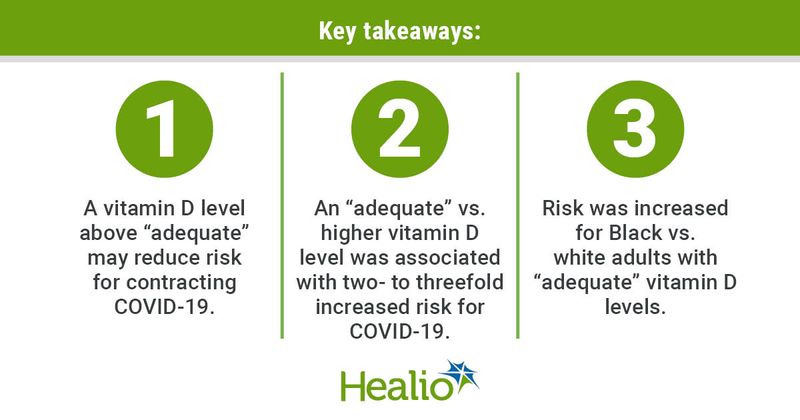Vitamin D level associated with COVID-19 risk for Black adults
Black adults with an adequate vitamin D level were still significantly more likely to test positive for COVID-19 compared with Black adults with a vitamin D level of at least 40 ng/mL, data from a single-center study show.
“The take-home message is that — especially for African Americans — having a vitamin D level that is higher than what has been traditionally considered ‘adequate’ may reduce the risk for developing COVID-19,” David O. Meltzer, MD, PhD, the Fanny L. Pritzker professor of medicine, chief of the section of hospital medicine and director of the Center for Health and the Social Sciences at the University of Chicago, told Healio. “Specifically, we found that having a vitamin D level as high as 30 ng/mL to 40 ng/mL, which is usually considered adequate, is associated with a two- to threefold increased risk for testing positive for COVID-19 compared with vitamin D levels greater than 40 ng/mL.”

Vitamin D, COVID-19 test data
In a retrospective, single-center study, Meltzer and colleagues analyzed data from 4,638 adults with available data on vitamin D level assessed within 1 year of a COVID-19 test conducted between March and December (mean age, 53 years; 69% women; 49% Black; 43% white). Researchers categorized the last vitamin D level before COVID-19 testing as deficient (< 20 ng/mL), insufficient (20 ng/mL to < 30 ng/mL), 30 ng/mL to less than 40 ng/mL, or at least 40 ng/mL. Treatment was defined by vitamin D type and dose 14 days before COVID-19 testing and treatment changes after last vitamin D level. Primary outcome was a positive result for COVID-19. Researchers assessed whether previously measured vitamin D level was associated with a positive test result for COVID-19 among white and Black adults, adjusting for months and treatment changes since the vitamin D level was measured.
Within the cohort, 27% of adults had a deficient vitamin D level, 27% had an insufficient level, 22% had a vitamin D level of 30 ng/mL to less than 40 ng/mL, and 24% had a level of at least 40 ng/mL. A deficient vitamin D level was more common among Black vs. white adults (36% vs. 16%).
Risk by race

Researchers found that 7%, or 333 adults, tested positive for COVID-19, including 5% of white adults and 9% of Black adults (P < .001).
In a model adjusted for time since last vitamin D assessment, the incidence rate ratio (IRR) between vitamin D level at least 14 days before COVID-19 testing and a positive test result for the entire cohort was 1.53 (95% CI, 0.91-2.56) for those with a deficient vitamin D level, 1.21 (95% CI, 0.68-2.13) for those with an insufficient level, and 1.42 (95% CI, 0.82-2.48) for those with a vitamin D level of 30 ng/mL to less than 40 ng/mL, compared with a vitamin D level of at least 40 ng/mL.
However, in a similar model restricted to Black adults, IRRs ranged from 2.64 (95% CI, 1.24-5.66) for those with a deficient vitamin D level, to 1.69 (95% CI, 0.75-3.84) for those with an insufficient level and 2.55 (95% CI, 1.26-5.15) for those with a vitamin D level of 30 ng/mL to less than 40 ng/mL, compared with Black adults with a vitamin D level of at least 40 ng/mL.
The IRR for a positive COVID-19 test for all adults in the cohort with a vitamin D level of 30 ng/mL or greater was 0.97 (95% CI, 0.94-0.99) per 1 ng/mL increase in vitamin D, and was 0.95 (95% CI, 0.91-0.98) per 1 ng/mL increase in vitamin D for Black adults.
“The vast majority of African Americans have vitamin D levels below 40 ng/mL in the absence of vitamin D supplementation,” Meltzer said. “Given the low risks of supplementation at low to moderate doses, it is reasonable to consider supplementation and/or testing of vitamin D levels, with a target of more than 40 ng/mL.”
Meltzer said randomized controlled trials are needed to know whether vitamin D supplementation can reduce the risk for developing COVID-19, especially among Black adults.
For more information:
David O. Meltzer, MD, PhD, can be reached at dmeltzer@medicine.bsd.uchicago.edu.


